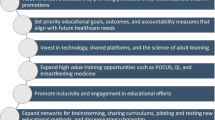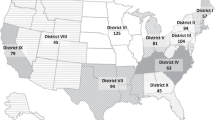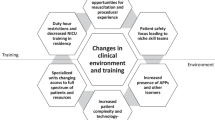Abstract
The clinical and academic landscape of Neonatal–Perinatal Medicine (NPM) is evolving. Career opportunities for neonatologists have been impacted by shifts in compensation and staffing needs in both academic and private settings. The workforce in NPM is changing with respect to age and gender. Recruiting candidates from backgrounds underrepresented in medicine is a priority. Developing flexible positions and ensuring equitable salaries is critically important. Professional niches including administration, education, research, and quality improvement provide many opportunities for scholarly pursuit. Challenges exist in recruiting, mentoring, funding, and retaining physician–scientists in NPM. Creative solutions are necessary to balance the needs of the NPM workforce with the growing numbers, locations, and complexity of patients. Addressing these challenges requires a multi-faceted approach including adapting educational curricula, supporting trainees in finding their niche, identifying novel ways to address work/life integration, and attracting candidates with both diverse backgrounds and academic interests.
This is a preview of subscription content, access via your institution
Access options
Subscribe to this journal
Receive 12 print issues and online access
$259.00 per year
only $21.58 per issue
Buy this article
- Purchase on SpringerLink
- Instant access to full article PDF
Prices may be subject to local taxes which are calculated during checkout
Similar content being viewed by others
References
Philip AG. The evolution of neonatology. Pediatr Res. 2005;58:799–815.
Alpert JS, Coles R. Careers in academic medicine. Triple threat or double fake. Arch Intern Med. 1988;148:1906–7.
Conti CR. Can the triple-threat academic physician exist in the new millennium? Clin Cardiol. 1999;22:499.
Stark AR. American Academy of Pediatrics Committee on Fetus and Newborn. Levels of neonatal care. Pediatrics. 2004;114:1341–7.
American Academy of Pediatrics Committee on Fetus and Newborn. Levels of neonatal care. Pediatrics. 2012;130:587–97.
Kourembanas S, Steinhorn R. In-house neonatology: what are we waiting for? Am J Respir Crit Care Med. 2010;182:728–9.
Horgan M. Neonatal outcome: role of change from on-call to in-house coverage model. Pediatr Res. 1997;41:153.
Bensouda B, Boucher J, Mandel R, Lachapelle J, Ali N. 24/7 in house attending staff coverage improves neonatal short-term outcomes: a retrospective study. Resuscitation. 2018;122:25–8.
Johnston L. Neonatology on-call models: a survey of members of the Organization of Neonatal Training Program Directors. unpublished data, 2019.
Wood AM, Jones MD Jr., Wood JH, Pan Z, Parker TA. Neonatal resuscitation skills among pediatricians and family physicians: is residency training preparing for postresidency practice? J Grad Med Educ. 2011;3:475–80.
Freed GL, Boyer DM, Van KD, Macy ML, McCormick J, Leslie LK. Variation in part-time work among pediatric subspecialties. J Pediatr. 2018;195:263–8.
Horowitz E, Feldman HA, Savich R. Neonatologist salary: factors, equity and gender. J Perinatol. 2019;39:359–65.
Freed GL, Moran LM, Althouse LA, Van KD, Leslie LK, Research Advisory Committee of American Board of Pediatrics. Jobs and career plans of new pediatric subspecialists. Pediatrics. 2016;137:e20153298.
Clarke TA, Maniscalco WM, Taylor-Brown S, Roghmann KJ, Shapiro DL, Hannon-Johnson C. Job satisfaction and stress among neonatologists. Pediatrics. 1984;74:52–7.
Register F. Medicare Program. CY 2021 payment policies under the physician fee schedule and other changes to part B payment policies (CMS-1734-P). 2020. https://www.policymed.com/2020/09/cms-2021-proposed-physician-fee-schedule-updates-to-telehealth-quality-payment-program-and-specialist-reimbursement.html.
Freed GL, Dunham KM, Loveland-Cherry C, Martyn KK, Moote MJ. Private practice rates among pediatric subspecialists. Pediatrics. 2011;128:673–6.
American Board of Pediatrics. Pediatric physicians workforce data book, 2018-2019.
Macy ML, Leslie LK, Turner A, Freed GL. Growth and changes in the pediatric medical subspecialty workforce pipeline. Pediatr Res. 2020;89:1297–303.
National Resident Matching Program. Results and data: specialties matching service 2020 appointment year. Washington, DC: National Resident Matching Program; 2020.
Institute for Healthcare Improvement. IHI Open School. 2021. http://www.ihi.org/education/IHIOpenSchool/Courses/Pages/OpenSchoolCertificates.aspx.
Wall J, Wynne E, Krummel T. Biodesign process and culture to enable pediatric medical technology innovation. Semin Pediatr Surg. 2015;24:102–6.
American Medical Informatics Association. Clinical informatics fellows vital to future of value-based care. 2020. https://www.amia.org/news-and-publications/press-release/clinical-informatics-fellows-vital-future-value-based-care.
Ahn J, Martin SK, Farnan JM, Fromme HB. The Graduate Medical Education Scholars Track: developing residents as clinician-educators during clinical training via a longitudinal, multimodal, and multidisciplinary track. Acad Med. 2018;93:214–9.
Fleming VM, Schindler N, Martin GJ, DaRosa DA. Separate and equitable promotion tracks for clinician-educators. JAMA. 2005;294:1101–4.
Greenberg L. The evolution of the clinician-educator in the United States and Canada: personal reflections over the last 45 years. Acad Med. 2018;93:1764–6.
Thomas PA, Diener-West M, Canto MI, Martin DR, Post WS, Streiff MB. Results of an academic promotion and career path survey of faculty at the Johns Hopkins University School of Medicine. Acad Med. 2004;79:258–64.
Buckley LM, Sanders K, Shih M, Hampton CL. Attitudes of clinical faculty about career progress, career success and recognition, and commitment to academic medicine. Results of a survey. Arch Intern Med. 2000;160:2625–9.
Varpio L, Gruppen L, Hu W, O’Brien B, Ten Cate O, Humphrey-Murto S, et al. Working definitions of the roles and an organizational structure in health professions education scholarship: initiating an international conversation. Acad Med. 2017;92:205–8.
Frank JR, Snell LS, Cate OT, Holmboe ES, Carraccio C, Swing SR, et al. Competency-based medical education: theory to practice. Med Teach. 2010;32:638–45.
Nasca TJ, Philibert I, Brigham T, Flynn TC. The next GME accreditation system–rationale and benefits. N Engl J Med. 2012;366:1051–6.
The Future of Medical Education in Canada – Post-graduate Project. The future of medical education in Canada: a collective vision for postgraduate medical education in Canada. 2012.
Sherbino J, Frank JR, Snell L. Defining the key roles and competencies of the clinician-educator of the 21st century: a national mixed-methods study. Acad Med. 2014;89:783–9.
Simpson D, Brownell Anderson M. Educational scholarship: how do we define and acknowledge it? 2006. www.aamc.org/professional-development/affinity-groups/gfa/faculty-vitae/defining-educational-scholarship.
Bauserman M, Vasquez M, Chess PR, Carbajal M, ONTPD Fellowship Directors Writing Group, Good M.J Perinatol. 2021. https://doi.org/10.1038/s41372-021-00957-3. Online ahead of print.
Good M, McElroy SJ, Berger JN, Wynn JL. Name and characteristics of National Institutes of Health R01-funded pediatric physician-scientists: hope and challenges for the vanishing pediatric physician-scientists. JAMA Pediatr. 2018;172:297–9.
Escobar GJ, Fischer A, Kremers R, Usatin MS, Macedo AM, Gardner MN. Rapid retrieval of neonatal outcomes data: the Kaiser Permanente Neonatal Minimum Data Set. Qual Manag Health Care. 1997;5:19–33.
Spitzer AR, Ellsbury D, Clark RH. The Pediatrix BabySteps(R) Data Warehouse–a unique national resource for improving outcomes for neonates. Indian J Pediatr. 2015;82:71–9.
Capan M, Hoover S, Jackson EV, Paul D, Locke R. Time series analysis for forecasting hospital census: application to the neonatal intensive care unit. Appl Clin Inf. 2016;7:275–89.
DeChant PF, Acs A, Rhee KB, Boulanger TS, Snowdon JL, Tutty MA, et al. Effect of organization-directed workplace interventions on physician burnout: a systematic review. Mayo Clin Proc Innov Qual Outcomes. 2019;3:384–408.
Accreditation Council for Graduate Medical Education. ACGME program requirements for graduate medical education in pediatric hospital medicine. 2020. www.acgme.org/Portals/0/PFAssets/ProgramRequirements/334_PediatricHospitalMedicine_2020.pdf?ver=2020-06-29-163350-912020.
Toronto Centre for Neonatal Health. Advanced neonatal training: neonatal hemodynamics subspecialty fellowship. Toronto Centre for Neonatal Health. 2021. https://torontocentreforneonatalhealth.com/education-opportunities/fellowships.
University of Iowa Healthcare. Neonatology Hemodynamics Fellowship. 2022 https://gme.medicine.uiowa.edu/neonatology-hemodynamics-fellowship2021.
Boston Children’s Hospital. Heart Center Cardiovascular Intensive Care Clinical Fellowship. 2022. https://www.childrenshospital.org/centers-and-services/centers/heart-center/education-and-training/cardiology-fellowship-program/cardiovascular-intensive-care-clinical-fellowship2021.
Children’s Hospital of Philadelphia. Pediatric Cardiac Critical Care Medicine Fellowship. Children’s Hospital of Philadelphia. 2021 https://www.chop.edu/pediatric-fellowships/pediatric-cardiac-critical-care-medicine-fellowship.
McGill University. Neonatal Hemodynamics Clinical Research Fellowship Program. 2022. https://www.mcgill.ca/peds/education-training/pgme/programs/neonatology/fellowship2021.
Association of Medical School Pediatric Department Chairs. Physician Scientist Development Program. Association of Medical School Pediatric Department Chairs. 2021. https://amspdc-psdp.org/.
Collins JW Jr., David RJ. Racial disparity in low birth weight and infant mortality. Clin Perinatol. 2009;36:63–73.
Lu MC, Halfon N. Racial and ethnic disparities in birth outcomes: a life-course perspective. Matern Child Health J. 2003;7:13–30.
Greenwood BN, Hardeman RR, Huang L, Sojourner A. Physician-patient racial concordance and disparities in birthing mortality for newborns. Proc Natl Acad Sci USA. 2020;117:21194–200.
Hoffman AM, Lapcharoensap W, Huynh T, Lund K. Historical perspectives: telemedicine in neonatology. Neoreviews. 2019;20:e113–e23.
Lantos JD, Meadow WL. Costs and end-of-life care in the NICU: lessons for the MICU? J Law Med Ethics. 2011;39:194–200.
Author information
Authors and Affiliations
Consortia
Contributions
JMT, ASK, PM, and LCJ conceptualized, drafted, reviewed, revised, and approved the manuscript as submitted, and agreed to be accountable for all aspects of the work. BS, JE, MG, DO, MCS, KS, and AP critically reviewed the manuscript. Consortium authors conceptualized the manuscript.
Corresponding author
Ethics declarations
Competing interests
The authors declare no competing interests.
Additional information
Publisher’s note Springer Nature remains neutral with regard to jurisdictional claims in published maps and institutional affiliations.
Rights and permissions
About this article
Cite this article
Trzaski, J.M., Kiefer, A.S., Myers, P. et al. Essentials of Neonatal–Perinatal Medicine Fellowship: careers in Neonatal–Perinatal Medicine. J Perinatol 42, 1135–1140 (2022). https://doi.org/10.1038/s41372-022-01315-7
Received:
Revised:
Accepted:
Published:
Issue date:
DOI: https://doi.org/10.1038/s41372-022-01315-7
This article is cited by
-
European training requirements in Neonatology 2021—towards a unified training standard for Neonatologists
Pediatric Research (2025)
-
One size does not fit all for URiM applicants: a comparison of NPM program size on URiM applications
Journal of Perinatology (2025)
-
Facilitating integration of international medical graduates into neonatal-perinatal medicine: a critical strategy to meet workforce demands
Journal of Perinatology (2024)
-
Academic neonatologist—a species at the brink of extinction?
Journal of Perinatology (2023)
-
Optimizing clinical care and training in the neonatal intensive care unit: the relationship between front line providers and physician trainees
Journal of Perinatology (2023)



